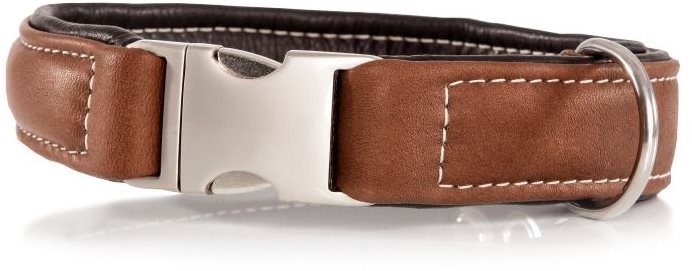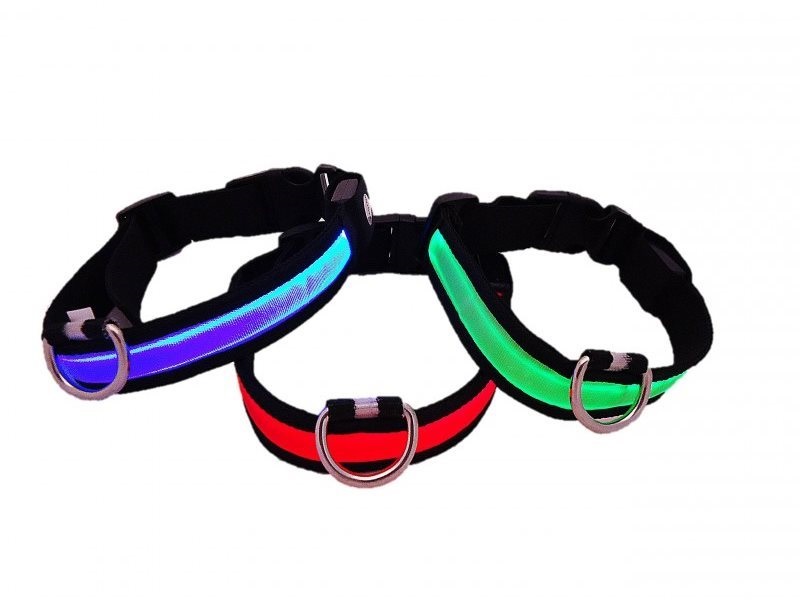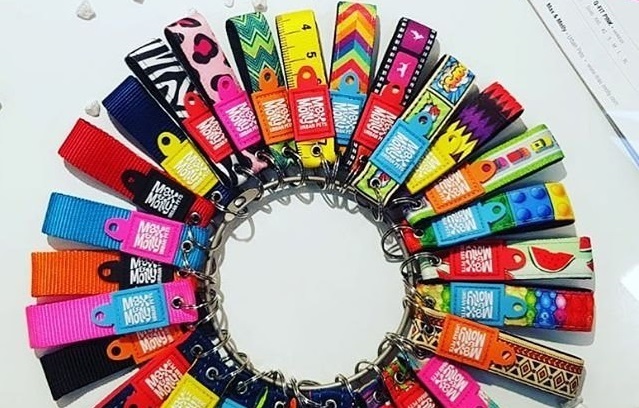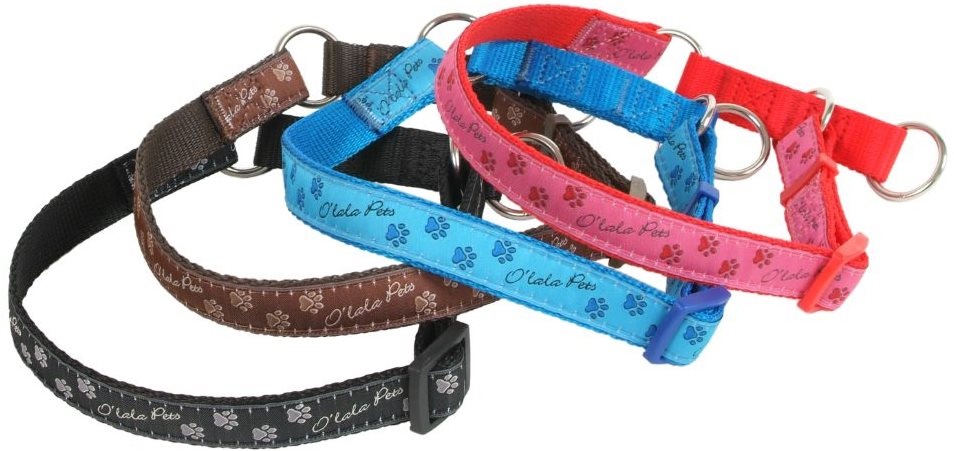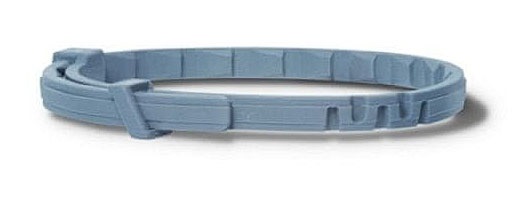How To Choose a Dog Collars
A good-fitting collar is essential for every dog. But how will you know which one to choose from such a wide range of different types? How to choose the right size and what material will best suit your dog? Our guide will advise you on what to focus on when choosing a good quality dog collar.
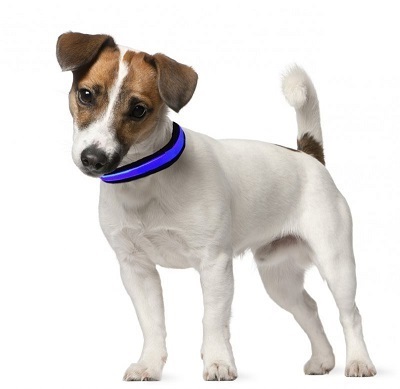
How to choose a dog collar – CONTENTS
- Tips for choosing a dog collar
- What is important when choosing a dog collar?
- Leather dog collars
- Nylon dog collars
- Luminous dog collars
- Designer dog collars
- Dog collars for training
- Semi-tightening dog collars
- Flea dog collars
- Accessories for dog collars
- Glossary - dog collars
Tips for choosing a dog collar
- Don't be seduced merely by an attractive design, choose a dog collar according to the size of your dog, its activities, coat length and the function you expect from the collar.
- Size matters above all, only a collar that has the right length and width will fit the dog well.
- In general, the smaller the dog, the narrower the collar and vice versa.
- Dog collars are not only designed to control and monitor your dog, they can also be an excellent aid in his/her training.
- Special dog collars also serve as a tool to prevent your dog getting fleas/ ticks, or to stop barking, or to monitor your dog’s movement.
What is important when choosing a dog collar?
Collar size
Collar width
Collar width up to 2.5 cm – is designed for small breeds of dogs weighing up to 10 kg in adulthood with a neck circumference (usually) of up to 30 cm.
Collar width of 2.5 to 3.5 cm – used for dogs weighing up to 25 kg in adulthood with a neck circumference of up to 40 cm. For more powerful dogs in this weight category, we recommend considering collars up to 4.5 cm wide.
Collar width 4 cm – recommended for dogs weighing around 40 kg in adulthood with a neck circumference of up to 60 cm. This width ensures the long-life of the collar and at the same time should not restrict the dog too much, so it is suitable for everyday wear.
Collar width from 4.5 to 7 cm – suitable for dogs weighing over 40 kg in adulthood with a neck circumference of over 60 cm. For dogs who weigh more or have a particularly muscular neck, a collar width of 5-6 cm is recommended. For dogs weighing about 70 kg then 7 cm.
Collar width 4 cm and more – also used for dogs with long necks and for those with a neck thicker than the head, such as greyhounds or fox terriers, who are at risk of damaging the spine when using narrow collars. Special semi-retractable collars are also suitable for these breeds.
Tip: Do not choose collars that are too narrow, they will strangle your dog - or too wide they will restrict your dog’s movement and breathing.
Type of collar
Sturdy collars – with a fixed diameter, fastening with a classic metal buckle (for leather collars) or a plastic buckle (for textile collars).
Semi-retractable collars – have a stop against complete retraction of the collar on the neck, the collar is retracted only to a certain extent so that it tightly encircles the dog's neck, but does not strangle him. They are most often metal, or a combination of a leather collar with a metal chain.
Clamping collars – Clamping collars do not have a stop against pulling the collar. They are used to teach the dog or prevent unwanted pull from the dog and are designed specifically for training and recommended for experienced handlers.
Purpose and function of the collar
Collars for casual wear – collars are usually wide enough, usually textile or leather, designed for walking in the city and nature. They are usually flat for the comfort of the dog.
Training collars – smooth metal or chain collars are best used for dog training, which can be easily switched to drawstrings. Fixed collars or semi-retractable collars are suitable for regular/ basic training.
Antiparasitic collars – they rid the dog of fleas or ticks. Their effectiveness is only temporary and you will probably only use them from spring to autumn.
Reflective, luminous and GPS collars – you can use luminous collars during visibility, so you can easily see where your pet is. GPS collars are suitable for owners whose dogs tend to explore an area independently.
Electronic collars – used for training and through 3 signals (a sound, vibrating pulse and electric impulse) alert the dog that they are disobeying a command or misbehaving.
Tip: It is always necessary to be sure that the collar will not loosen or break even under extreme strain. Therefore, it is important to check the condition, connections and fastening of all types of collar.
Collars according to the material
Leather collars – are very strong, made of natural material and, with proper care, have a long life. However, water does not suit them, compared to textile collars, they are heavier and are usually more expensive.
Textile collars – their main advantages: they are light, cheap and come in a wide range of sizes, colors and patterns. They are very popular among a lot of dog owners.
Metal collars – are especially suitable for short-haired dogs and are usually used in training. Although they are heavier, they are popular because they last for a very long time and are easily maintained.
Frequently asked questions about leather dog collars
How do I choose the right size of leather collar?
Leather collars are fastened with holes (like a belt), so when choosing the right size take note of the length of the entire collar and make sure it is long/ short enough to comfortably fasten around your dog’s neck.
Nylon is a high-quality lightweight material that is at the same time sufficiently strong, durable, easy to clean and tolerates water well. The advantage of nylon collars is, in addition to them being light-weight, dog owners can choose from a large number of colors, types and sizes, at a reasonable price. They are fastened with plastic or metal clips.
Frequently asked questions about nylon dog collars
Are nylon collars suitable for larger dogs?
For larger dogs, choose sufficiently wide nylon collars, corresponding to the size and strength of the dog. Preferably with a metal buckle. This will avoid the unpleasant situation where the dog goes forward quickly and the buckle breaks or a loop is torn off. In general, plastic buckles are the least reliable and can break under strain.
Are nylon collars waterproof?
Nylon collars deal with water very well and can be washed frequently. For dog swimming, we recommend waterproof neoprene collars.
Luminous collars are a great help in the dark or fog and act as a reliable safety feature. They either light up permanently or flash. They are a guarantee that you will see your pet even at dusk or during the night. It protects the dog even when moving in the city, because it makes them more visible to drivers and cyclists. The practical luminous collar can easily be shortened or adjusted to the optimal size for your dog.
Frequently asked questions about luminous dog collars
How long do collars last after being charged?
The collar can be charged using the USB cable included in the package. Battery life after charging is usually 2 to 3 hours. Or a replaceable button battery is integrated directly into the collar.
Can I use the luminous collar as a regular collar?
Most luminous collars are not equipped with a hoop to attach a leash. The dog must have his normal collar at the same time. If you do not want to give your dog two collars, you can, for example, put luminous or reflective tape on a regular collar.
The collar is not only a practical aid, but it can also underline your dog’s personality with its own design. With designer collars, you can expect maximum functionality combined with an attractive and original look thanks to quality materials. Individual adjustments according to the customer's wishes is possible.
Frequently asked questions about designer dog collars
How much do I pay for a designer collar?
You can buy an original designer collar relatively cheaply, design pieces from more well known brands are more expensive. The prices of luxury designer collars from leading designers then climb to up to astronomical heights.
Electronic collars are effective helpers for dog training. Through a three-signal setting (sound, vibrating pulse and electric pulse), the electronic collar alerts the dog that they are disobeying a command or misbehaving. Even a minimal set sound or vibration pulse, which the dog can barely feel, will give him a signal that something is required of him. With the electronic collar it is possible to train the dog without a leash, at different distances according to the range of the device.
Frequently asked questions about training collars for dogs
Can electronic collars cause problems for the dog?
Electronic collars are a suitable helper for dog training if they are used correctly. Under no circumstances should electric impulse collars or anti-bark collars be used to punish a dog, and their use should, as far as possible, be limited to training.
Semi-tightening collars are usually made of metal. The ends of the fixed chain are finished with rings, through which another simple chain is threaded. The semi-tightening collar can be put on the dog comfortably. It is partially tightening so that the dog cannot pull himself out of the collar. It tightly encircles the dog's neck, but does not strangle him.
Frequently asked questions about semi-tightening dog collars
What is the difference between a semi-tightening and a tightening collar?
Semi-tightening collars have a stop against complete tightening of the collar, and therefore do not strangle the dog. On the other hand, a tightening collar does not have a stop like a semi-tightening one, so there is a risk that the dog will start to strangle. Therefore, tightening collars, unlike semi-tightening collars, should be used only by experienced handlers, eg. for the training of otherwise unmanageable dogs.
Owners use these collars to rid their dogs of ticks, fleas and other parasites. The material of the collar contains a chemical that repels ticks and fleas and even kills them. The active substances contained in it are released continuously and in small doses into the skin of the animal. However, the effectiveness of antiparasitic collars is limited. You will use them mainly from spring to autumn, during the parasite high season.
Frequently asked questions about flea dog collars
Do flea collars pose a health risk to your dog or to humans?
The collars are completely non-toxic, waterproof and some types do not even smell. No need to worry about contact. They are completely safe and do not irritate the skin or eyes.
Accessories for dog collars
GPS locators
With a GPS locator, your dog will no longer get lost. Dog locators use GPS technology, so you get accurate information about the current location of your dog. GPS locators are an ideal preventive measure for all owners who want to keep their dog safe and under control. Monitoring of the dog using a GPS locator can be set at home, and set to escaped or tracking mode. They use a SIM card or a radio connection for communication. They are easy to attach to the collar and are waterproof.
Collar lights
With a light which you simply attach to the collar, you can safely take your dog on evening walks in nature, because you will see them up to a distance of 5 km. Powerful and durable lights do not disturb your dog. They are waterproof and can withstand strong shocks and higher temperatures. Not only dog owners but also rescue dog handlers really like them.
Tip: If you switch to flashing mode, the lights can work for up to 250 hours - in continuous lighting mode for up to 100 hours.
Glossary - dog collars
Martingale collar
Martingale collars are semi-tightening collars with a stop that prevent the collar from being completely tightened. This means the collar won’t strangle the dog but at the same time they won’t be able to slip out of it.
Anti-barking collar
It is a special type of electronic collar that can help prevent excessive barking through an electrical impulse. However, anti-barking collars do not solve the reason for the barking, so their use should be done in consultation with experts and limited to training only.
Escape mode
If the dog moves away from his home the device immediately records this and reports it to the dog owner’s mobile phone via SMS. At the same time, the GPS locator itself switches to a mode that monitors the dog’s movement and has a range of several km from the home.
Glossary
